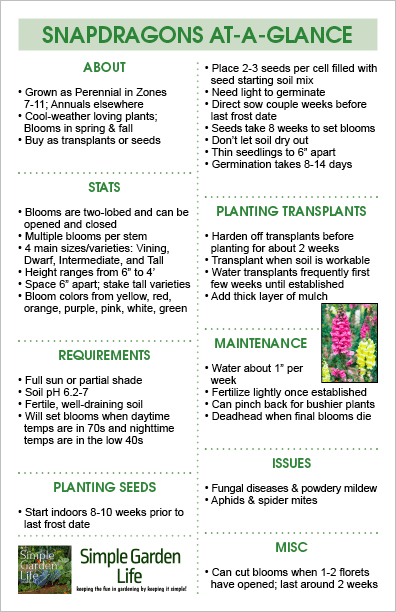Snapdragons are one of the most interesting and versatile flowers that you can grow. Not only do they come in almost every color of the rainbow, but this cool-weather-loving plant’s unique blooms make them a great addition to your property. All you need is a few simple tips and you’ll know how to grow snapdragons in no time!
The name “Snapdragon” comes about because of their unique two-lobed blooms. When a bee lands on the curved bottom lobe, the bloom literally opens and closes. You can even try it yourself by gently squeezing together the sides where the lobes meet. This feature makes the snapdragon blooms look like they are a dragon’s mouth opening and closing.
While snapdragons are technically an herbaceous perennial, they are grown as annuals in most locations that don’t have mild winters. They have a hardiness zone of 7 to 11 as a perennial. (Find your own Growing Zone Here.)
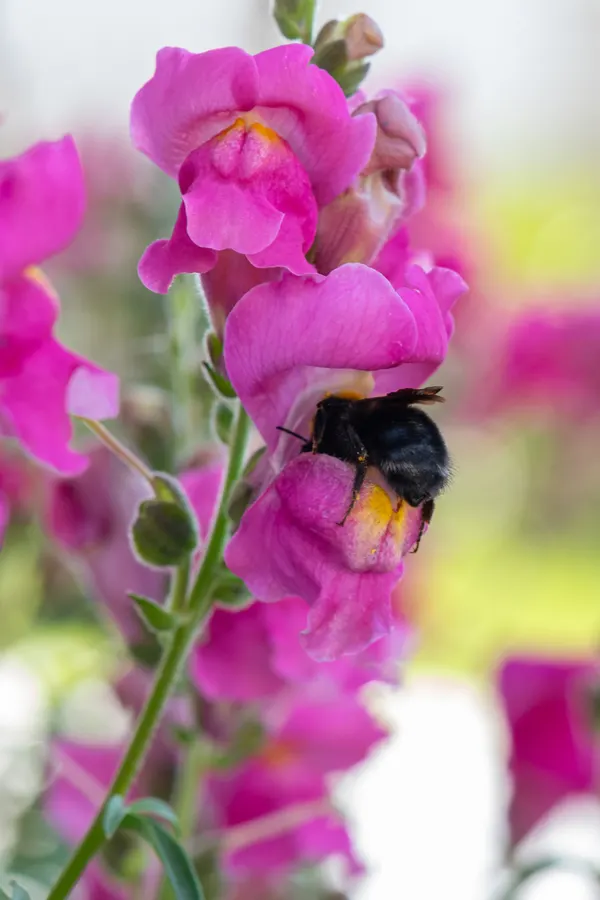
Bonus Blooming Season!
Snapdragons bloom prolifically in the cooler Spring months, but they start to slow down production once the heat of summer hits in July and August. However, with proper care, watering, and pruning, snapdragons will begin to bloom again in the cooler fall months giving you lots of added enjoyment all from one planting.
Varieties of Snapdragons – How To Grow Snapdragons
Snapdragon varieties come in four main sizes and styles: Vining (grows on vines up to 2 feet long), Dwarf (grows between 6-12” and are dense and bushy), Intermediate (grows between 1-2 feet tall), and Tall (grows between 2-4 feet tall). The tall varieties make great plants for beddings and borders or as cut flowers. The shorter varieties are perfect for raised beds and containers.
Their bloom colors range from yellow, red, orange, purple, pink, white, green, and lots of combinations of colors. Pretty much any color of the rainbow, with the exception of blue. Snapdragons have multiple florets per stem. The florets open from the bottom up.
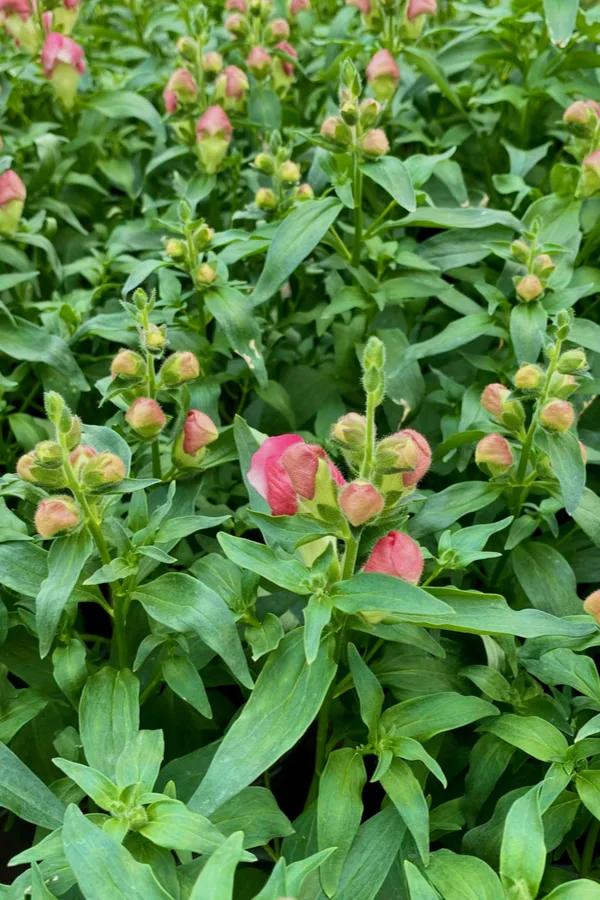
How To Plant, Grow, And Maintain Snapdragons
Soil Requirements for Snapdragons
Snapdragons prefer soil that is fertile and well-draining. Amend the soil prior to planting by adding in some compost and mixing well. Not only does the compost help to add nutrients, but it also helps to loosen the soil to allow better root growth.
They prefer a soil pH of around 6.2 to 7.
Since snapdragons are cool-loving plants, they will set blooms best when the nighttime temperature is in the low 40ºs Fahrenheit (4º Celsius) and daytime temperatures of low 70ºs Fahrenheit (21º Celsius).
Planting Snapdragons
While you can plant snapdragons directly from seeds or as a transplant, they take a long time to set blooms. It takes around 8 weeks from the time you plant until the time the blooms open, and since they stop blooming in warmer weather, most gardeners opt for planting transplants.
If you don’t want to start the seeds yourself indoors, you can likely find snapdragon transplants in nurseries and greenhouses as well later in the Spring.
Start your snapdragon seeds indoors 8-10 weeks prior to your last frost date. You can find your Last Spring Frost Date Here.
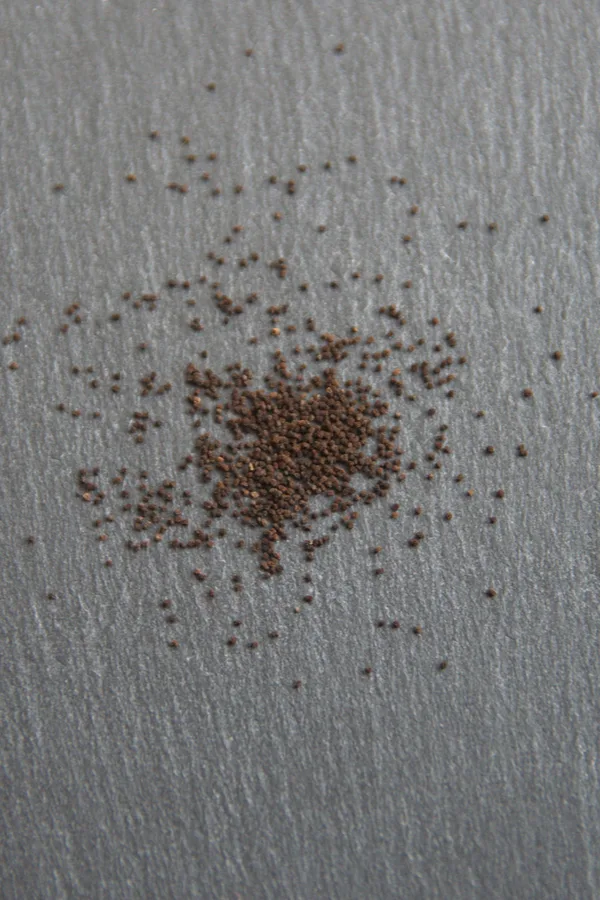
The seeds of a snapdragon plant are exceptionally small and can be difficult to work with. Use a pair of tweezers or a slightly moistened toothpick to transfer 2-3 seeds per cell. You don’t want to cover the seeds with soil because they need light in order to germinate (so make sure to turn on those grow lights right away).
Proper Germination
It is really important to keep the soil moist to allow good germination and growth. This applies whether you are starting seeds indoors or direct sowing.
If you prefer direct sowing, plant seeds a couple of weeks before your last frost date. Snapdragons can tolerate some light frost once they have a few sets of leaves. Just keep in mind that with direct seeding, your blooms will be delayed a bit. Space seeds 6 inches apart.
Snapdragons grow best in locations of full sun (at least 6 hours), but they can tolerate partial shade. When transplanting, space plants 6 inches apart.
Tall varieties might need staking, especially if they are located in a windy location. Consider this when transplanting or direct sowing.
Long-Term Care – How To Grow and Maintain Snapdragons
Germination should take around 8-14 days. If you sowed seeds closer than 6 inches apart, you will need to thin plants once they are a few inches tall.
Before you transplant young plants into the ground, make sure to harden off your snapdragons by placing them outside for a few hours at a time. Gradually increase this amount of time so they can get used to the elements such as wind and fluctuations in temperatures. Give plants about two weeks to get used to outside elements before you place them in the ground.
It is beneficial to add a thick layer of mulch when you are growing snapdragons in flowerbeds (around 3-4 inches). This will help to keep the soil moist as well as help to stop weeds from taking over and stealing valuable nutrients from the snapdragons.
Pinching and Deadheading
To get bushier plants with more blooms, you can choose to pinch back plants once they are established in the spring. This works best on the smaller varieties of snapdragons.
Pinch back plants once they are a few inches tall and have multiple sets of leaves. Use clippers to remove the top part of the plant, leaving only 2-3 sets of leaves behind. You can pinch again during the later summer months once blooming has slowed to produce more stems for the fall blooming.
You should also deadhead spent blooms as soon as the final set of blooms on a stem start to die off. This will force the plant to start new bloom cycles.
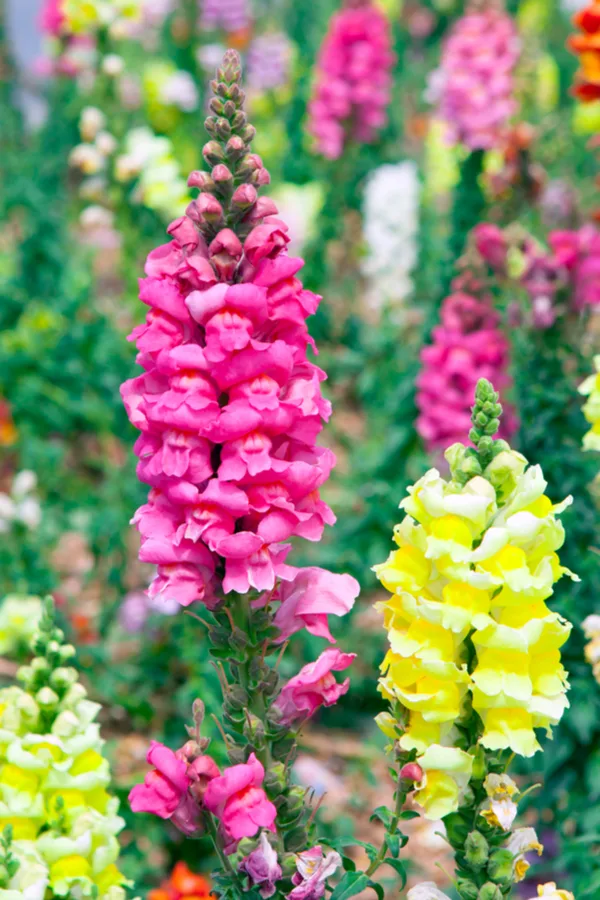
Watering
Proper water and moisture are really important to snapdragons’ health and productivity. If growing from seeds, never let the soil dry out to make sure you get proper germination and seedling growth. You don’t want the soil completely saturated either, so it can be kind of a balancing act to get the right amount of moisture.
Water transplants frequently in the first few weeks to allow the roots to become established in the soil. Once established, snapdragons require about an inch of watering or rainfall each week. It might be useful to keep a rain gauge in your garden to help keep track.
If you are growing snapdragons in pots or containers, they will likely need to be watered more frequently. Use your finger to check the soil’s moisture level. If it feels dry to the touch an inch or so down, then you need to water.
Fertilizing
Once snapdragons are established, they can benefit from a light dose of fertilizer. Keep in mind that a slow and steady application of fertilizer is much more useful than a heavy dose all at once.
For snapdragons in flowerbeds or your garden, fertilize monthly with either an all-purpose liquid fertilizer or a slow-release granular fertilizer. Make sure to fertilize early in the morning so you don’t chance burning your plants with the heat of the day.
For snapdragons that are in pots and containers, apply a light application of liquid fertilizer every couple of weeks. Compost tea or worm castings are two perfect types of slow-release fertilizers. You can learn more about these and other great fertilizers by listening to the podcast, How To Fertilize Your Vegetable Garden.
Pests & Issues
Snapdragons are susceptible to fungal diseases and powdery mildew. Make sure to only water your plants at the base of the stem so the leaves don’t get and stay wet (and always water either early in the morning or late at night).
Also, if using mulch, keep it back a couple of inches from the stem. Both practices can help prevent fungal diseases, as well as keeping the proper spacing between plants to allow for good airflow.
Snapdragons are also great hosts for your typical garden pests like aphids and spider mites. Check plants daily to keep an eye out for any pest damage.

Cuttings From Snapdragons
Tall varieties of snapdragon blooms make for excellent indoor arrangements or bouquets! Harvest stems when 1-2 florets have opened up at the bottom and the rest remain closed. Cut stems at an angle and immediately place them in water. The snapdragon cuttings can last around 2 weeks when done properly.
To Conclude…
If you would like to add color and interest to your garden from June all the way to October, then snapdragons are definitely the flower for you! Just don’t spend too much time opening and closing their unique blooms, or the bees might get mad!
Feel free to download, print out, or save our Snapdragons At-A-Glance sheet. It is sized for half letter printing but can be scaled if needed.
